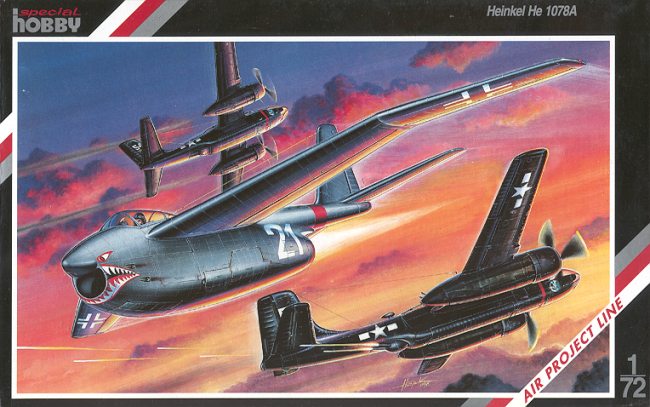
Special Hobby 1/72 He-1078A
|
KIT # |
72007 |
|
PRICE: |
$14.98 |
|
DECALS: |
One aircraft |
|
REVIEW : |
|
|
NOTES: |
Short run with etched bits |

|
BACKGROUND & ALTERNATE HISTORY |
For information on the plane and to see what's in the kit, see the preview.
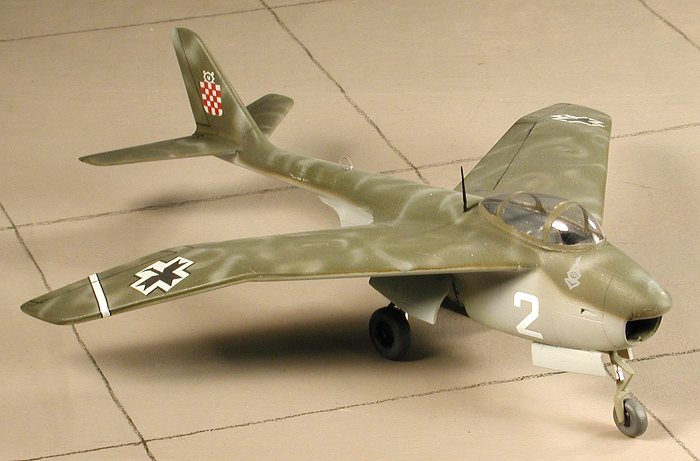
Sgt. Branko Glumac was an extremely lucky young man. Not only had he been chosen to fly the new Heinkel 1078 fighters, but he had also had the good fortune to have as his first assignment, the 105th Eskadrila, 33rd Grupa, 4th Puk in defense of Zagreb. Nothing could have been more of a dream assignment. Far from any actual fighting other than the occasional Allied long range recce or even more rare bomber intrusion. Close to good food, comfortable living and the babes. Man, they knew the guys who flew the jets and flocked to them whenever they appeared in the local pubs. On top of all that, he got to fly one of the most fun planes he has ever flown since he joined the Croatian AF.
Most of the rest of his fellow pilots from school were assigned to anti-partisan operations. There they were flying slow prop driven aircraft or combat helicopters in a seemingly never-ending war against guerilla fighters in the mountains. Living at advanced bases in tents and slogging through the mud, or sand or snow depending on the weather. No way will they ever let their precious jet fighters operate in those conditions. Even the old Me-262Bs he flew in jet training were flown from well prepared flying fields. Same for the He-162s that were used for advanced fighter tactics. Frankly, he never really liked the He-162s. Sure they were small and fun to fly, but they also tended to break a lot. Several friends had been killed when the planes were overstressed and broke up in flight. No so these nice 1078s!
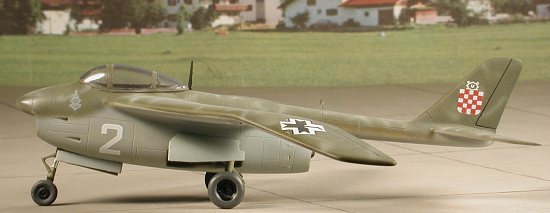 However, that assignment was not a permanent one. The top brass liked to swap
units around and give everyone a taste of the good life. When the 105th got
orders, it was with much interest and speculation on where they would be sent.
All partner states in the Axis had to send units to fight with the Germans. It
was part of the deal. However, Branko knew that the 1078s would not be sent
anywhere that did not have a nice, big airfield and good support. These jets
still needed lots of room and were still not the most reliable planes around.
Air defense was their forte.
However, that assignment was not a permanent one. The top brass liked to swap
units around and give everyone a taste of the good life. When the 105th got
orders, it was with much interest and speculation on where they would be sent.
All partner states in the Axis had to send units to fight with the Germans. It
was part of the deal. However, Branko knew that the 1078s would not be sent
anywhere that did not have a nice, big airfield and good support. These jets
still needed lots of room and were still not the most reliable planes around.
Air defense was their forte.
When the orders were posted in the common room, he couldn't believe it. They were being sent half way around the world! To exotic Bali, no less in what used to be the Dutch East Indies. Thoughts of beautiful native dancing girls floated through his mind. This might not be so bad!! with a smile on his lips, he packed up and headed for his last night in civilization for a few months.
After a relatively long sea voyage, fraught with false alarms and monotonous days, the ship pulled into port at Singajour where their aircraft were off loaded. After being towed through town to the nearby airfield, they were given a thorough inspection and repainted a dark green color with light blue mottling on the upper surface to blend in with the local vegetation. A black bordered white stripe was painted on the wing as a form of ready ID mark for the area. Checking over everything, the Branko's plane was given the OK for flight and test flown to make sure all was operating properly.
Here it was, early 1947 and the Japanese had basically been stalemated with the US and Australia for the last year or so. They had been driven out of Burma and then retook most of the territory in late 1944/1945 when the flow of Allied troops and materiel to the area had slowed to a trickle. The Allies need the troops more in Africa to combat the Germans and other European Axis partners. The Japanese had no such ready help so it was determined that other Axis countries would supply units for defense in areas not under imminent danger of attack. In fact, the Japanese had done well in China, but an unusual setback had them on the defensive and they were pouring all available units into the area.
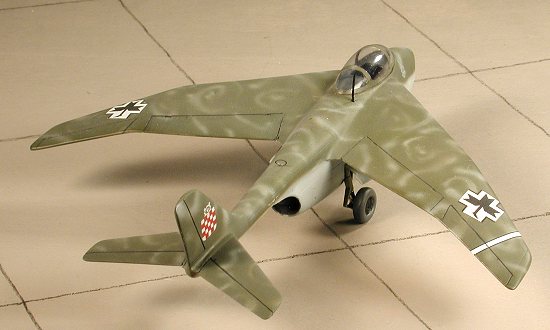 Coming into a landing at the
'secret'
Japanese airstrip that would be home for the next half year, he noticed that there were a few Japanese planes
sitting in revetments. These were mostly twin engined types like the Ki-83 and
Ki-102 with a few Ki-87s. (Having little else to do on the voyage, he spent long
hours with friends going over aircraft recognition.) He saw no turbojet powered
aircraft at all. In fact, he had a sneaking suspicion that these were the first
in the area. His landing on the rather bumpy grass landing field was uneventful,
though it stirred up a considerable amount of dust. As he bounced his way to the
parking areas, he notice that there was quite a crowd gathered.
Coming into a landing at the
'secret'
Japanese airstrip that would be home for the next half year, he noticed that there were a few Japanese planes
sitting in revetments. These were mostly twin engined types like the Ki-83 and
Ki-102 with a few Ki-87s. (Having little else to do on the voyage, he spent long
hours with friends going over aircraft recognition.) He saw no turbojet powered
aircraft at all. In fact, he had a sneaking suspicion that these were the first
in the area. His landing on the rather bumpy grass landing field was uneventful,
though it stirred up a considerable amount of dust. As he bounced his way to the
parking areas, he notice that there was quite a crowd gathered.
As he deplaned he was greeted by women putting flowered wreaths over his head and a number of very pleased looking Japanese. As he was driven to the briefing room, he noticed that most of the Japanese planes in the revetments were unserviceable, with parts and panels missing from the planes. It seems as if the Japanese supply system doesn't work too well. Fortunately, they brought with them a rather large quantity of spares for their 6 month deployment.
During the briefing it was verified that there were no active Japanese air units on the base and that the Japanese planes were indeed derelict, despite being new types. The Japanese had no real supply system so cannibalized what they needed from other planes. They also found that they were tasked with defense of a rather large area. Allied air intrusions were few and far between, but it was sure that they would send over something from Australia once their presence was discovered by high flying recce birds.
Living conditions were pretty basic, in fact, they were down right crude compared to what they had back home. There was no really close town and many of the locals hated the Japanese, but had to rely on them for work. The usual bars and brothels were set up just outside the base by enterprising Balinese and while one could have an entertaining evening, it was best to go with friends to prevent major trouble. At least the weather was nice!
After a couple of weeks of orientation flights, the squadron was feeling pretty much at home. They'd even made improvements in the base itself by putting down a macadam-like substance on a long section of the landing field to make it smoother as well as putting the stuff on the hardstands. The dirt portion of the revetment behind the jet exhaust was also covered with metal to better absorb the heat and stop the small fires that inevitably started during engine operation. Made things much nicer. During all this time, there was not a hint of Allied aircraft, despite the relative closeness of Australia. It was difficult to even believe there was a war going on. All this was about to change.
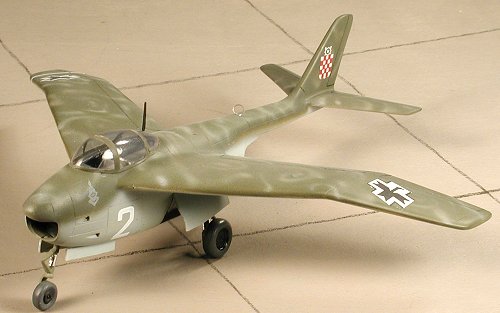 Branko awoke with a start one
morning to the sound of explosions and aircraft engines. The field was under
attack! Jumping into his flight suit and boots, he hurried out to the field to
see what was going on. The Australians had managed to sneak a flight of B-29s
under the radar and were now dumping tons of bombs on the field. They were
escorted by twin-engined fighters that were strafing the field in an attempt to
gun down anyone (like him) who was foolish enough to come outside. Branko dove
into a slit trench that had a small pool of water in the bottom of it from the
rains the other day. Man, just what he needed! Being fired upon and a mud bath!
To say he was scared would be an understatement, but there was little he could
do but wait out the attack and hope his plane wasn't destroyed or damaged.
Branko awoke with a start one
morning to the sound of explosions and aircraft engines. The field was under
attack! Jumping into his flight suit and boots, he hurried out to the field to
see what was going on. The Australians had managed to sneak a flight of B-29s
under the radar and were now dumping tons of bombs on the field. They were
escorted by twin-engined fighters that were strafing the field in an attempt to
gun down anyone (like him) who was foolish enough to come outside. Branko dove
into a slit trench that had a small pool of water in the bottom of it from the
rains the other day. Man, just what he needed! Being fired upon and a mud bath!
To say he was scared would be an understatement, but there was little he could
do but wait out the attack and hope his plane wasn't destroyed or damaged.
When all the noise died down, he looked around. Everywhere there seemed to be smoke and fires set by the attacking planes. He rushed to see if 'his' plane was intact. Fortunately, all looked to be OK. He looked around for a mechanic to hook him up and start his plane. Others were doing the same thing. It appeared that several of the jets had been saved from destruction while others were smoking wreckage. Those that were flight ready were firing up and beginning to taxi out to the runway. Once there, they were given a heading for the departing Aussies and the planes leapt into the air.
It seems as if there were about seven or so of them able to get airborne. Branko looked over his instruments and made sure that everything was operating normally. The flight leader had everyone fire a few rounds of the three 20mm cannon to make sure all was working. Ground control was leading them to the enemy as the little jets had no radar. They were closing rather rapidly and it only took a few minutes before they saw the lumbering Superfortresses. Their escort saw the jets closing and turned to attack.
Machine gun fire erupted from between the engines of the defending planes as the escort sped by. Branko was unable to get any shots off at them, but did recognize them as P-82s, a two-man, twin-engined escort fighter. They were painted a dark color and had the usual white and blue Australian markings. The flight closed up on the olive drab B-29s and soon the defensive fire opened up on what seemed to be about a dozen bombers. The flight split into several sections in order to break up the defensive fire. Branko went with two others as there were an uneven number of aircraft.
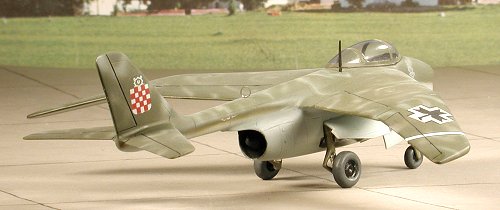 His section swooped out to the
left and then cut into the bombers in a classic pursuit curve. Branko opened
fire and saw a few hits, but it was not enough as the bomber cruised on. They
tried an underside attack and the leader was successful in starting an engine
afire on one plane. This caused it to slow down and the B-29 started to fall
back. By this time the escorts had become a real nuisance and made it difficult
to properly attack.
His section swooped out to the
left and then cut into the bombers in a classic pursuit curve. Branko opened
fire and saw a few hits, but it was not enough as the bomber cruised on. They
tried an underside attack and the leader was successful in starting an engine
afire on one plane. This caused it to slow down and the B-29 started to fall
back. By this time the escorts had become a real nuisance and made it difficult
to properly attack.
Branko's group decided to put some of their efforts into dealing with the escort. The P-82s were pretty quick and quite maneuverable compared to the Heinkels. The only way one could succeed was with a high speed attack. After a few attempts, Branko managed to get one in his sights and squirted a number of rounds into the escort. Parts flew off and the right engine started to smoke heavily. The plane headed to the ocean below in a slow spiral. Branko saw one parachute open below and then turned his attention to the other escorts.
By this time, the fight had moved farther south. A call on the radio to break off and return to base was acknowledged by six of the pilots and the flight headed back to Bali. Post flight inspection showed a few bullet holes, but nothing that couldn't be repaired. Branko and two others had gotten P-82s while one B-29 had been brought down. One Heinkel had been shot down by the B-29s, and air-sea rescue was on its way to pick up any survivors. Branko and his friends had finally seen combat. It was everything he had hoped it would be and was hoping for more action during his tour.
|
CONSTRUCTION |
This particular kit is one of the first ones produced by Special Hobby. As such it is basically a rather crude kit. Not an impossible one, just a bit less user friendly than what one would get from the company today. There is a benefit to these older kits in that there is no resin included. In fact, the non styrene parts are limited to a generic etched fret with rudder pedals, harnesses, antennas and the like, and a single vacuformed canopy.
Construction starts with removing the large pieces and then cutting off all the little ejector stubs that are on the inside. A quality pair of flush sprue cutters such as the Xuron ones will go a long way to making this an easy task. There is one, however that will be a pain as it is right in the middle of a small shelf on which the cockpit interior fits. You'll have to do some careful cutting and hacking to remove it.
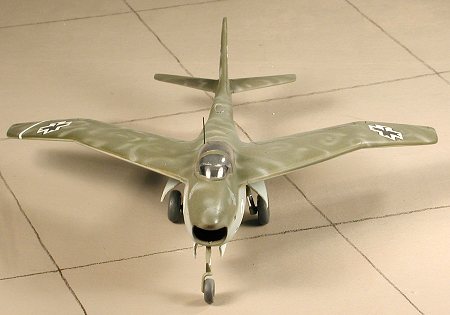 With that done, the wings were assembled. Due to the gull, I
glued the outer section first and when it was dry, did the inner section. I have
recently been using a truly cool tool to put on glue. It is a precision
applicator. Actually, it is nothing more than a glass tube with some very small
diameter tubing in the end. You use it like a pipette. I have tossed my glue
brushes and use this thing all the time. If you get a chance, you should really
give it a try. They run about $8 or so.
With that done, the wings were assembled. Due to the gull, I
glued the outer section first and when it was dry, did the inner section. I have
recently been using a truly cool tool to put on glue. It is a precision
applicator. Actually, it is nothing more than a glass tube with some very small
diameter tubing in the end. You use it like a pipette. I have tossed my glue
brushes and use this thing all the time. If you get a chance, you should really
give it a try. They run about $8 or so.
With the wings drying, the interior was assembled. Actually there is little to it. Just a floor, back bulkhead, instrument panel, and a seat in styrene. The control you have to make and there are etched rudder pedals and seat belts. Forget the pedals as you won't see them. You do need to test fit the interior a number of times to get it to fit as it is a bit too wide. The instrument panel will need trimmed a number of times as well as it is also too wide. The exhaust area is a lot smaller in diameter than you might think. I had mine just barely glued in place and when the fuselage was joined, there was a gap at one side and the exhaust 'bullet' is off center as a result. Perhaps making a backing plate out of plastic card is to be considered.
Before closing the fuselage halves, make sure that you get the intake in there properly and add some weight to it. Once the fuselage is together, it is time to do some serious sanding and filling. The area under the nose where the intake fits is particularly poor so will need several applications. Gluing on the tailplanes was trouble free. Make sure that the joining surface is flat and there will be no problems. Same with the wings. Mine were not so I had to do some extra filling once they were glued on. Getting the proper dihedral on them is also very important or they just won't look right. This will require some fiddling around while the glue sets. I did not use any reinforcing pins for them nor did I use superglue. My standard Ambroid liquid glue worked just fine.
With the airframe complete, the vac canopy was cut as best as I could (I'm really not good at these things at all no matter how much I try) and attached using non-fogging superglue. Those seeking extra detail in the cockpit need to add things like a gun sight and perhaps some armor plating for the pilot's head. None is supplied and I didn't fit any. It will go a long way to improving the look of the cockpit.
|
PAINT & DECALS |
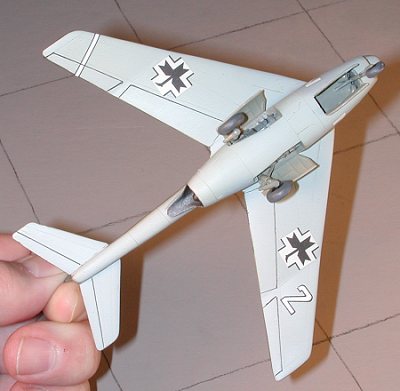 At this time, it was off to the paint shop. As always, I wasn't really
sure what camo scheme I was going to use. The kit box shows a bare metal one,
but I like to do camo. To that end, the underside of the plane was painted RLM
76. When dry, the tailplanes were masked off and the upper surface painted an
overall RLM 82 dark green. This was later oversprayed with swirls of RLM
76 and then a light coat of RLM 82 misted over the top of it to tone it down. It
actually looks pretty neat. This is the fun part of Luft '46 model building as
there are no rules!!!!
At this time, it was off to the paint shop. As always, I wasn't really
sure what camo scheme I was going to use. The kit box shows a bare metal one,
but I like to do camo. To that end, the underside of the plane was painted RLM
76. When dry, the tailplanes were masked off and the upper surface painted an
overall RLM 82 dark green. This was later oversprayed with swirls of RLM
76 and then a light coat of RLM 82 misted over the top of it to tone it down. It
actually looks pretty neat. This is the fun part of Luft '46 model building as
there are no rules!!!!
With the paint on, the landing gear were glued in place after having the oleos wrapped in BareMetal Foil. Then the kit was taken to the paint shop for a gloss clear coat in anticipation of the decals. It was at this time that I discovered I didn't put enough nose weight in it. Oh well, at least the nose gear bay is plenty big enough! The smaller struts were attached to the gear and these really made them quite sturdy.
Rather than use the usual German markings, I went with something a bit different. Scrounging through my decal sheets I found an Almark sheet that had Croatian markings. That would fit the different bill just fine. Digging around some more, I found a knights helm from an F-18 decal sheet to use for a unit badge. The numbers were taken from the kit decal sheet. Solvaset was used on them and it worked fairly well, though the Almark decals didn't react as well as a Superscale or Aeromaster decal would.
With the decals in place, the kit was given a coat of flat clear and returned to the work bench for the addition of some more bits and pieces.
|
FINAL BITS |
At this juncture, the masking was removed from the canopy. Then a few antennas were removed from the etched metal fret and installed on the plane. These were brush painted the appropriate color. The wheel wells also had some touch up done with RLM 02. Then the wheels were attached. The main wheels have just a teeny stub to fit into an indentation on the landing gear. This was a bit of a fussy fit, but enough glue and long drying time were enough to get them to fit well. Finally, the landing gear doors were glued in place. A little bit of final paint touch-up and the kit was done.
|
CONCLUSIONS |
An easy built it isn't. I wasn't expecting it to be. Face it, short run kits are not for every modeler as they require patience and skills that take a while to learn. However, they are often the only way you can get some of these more interesting subjects without having to resort to vacuform or resin kits. They are also pretty inexpensive and leave room for you to add stuff if you so wish. If you like the subject and have the skills to tackle these kits, they are a very interesting addition to your display case.
November 2001
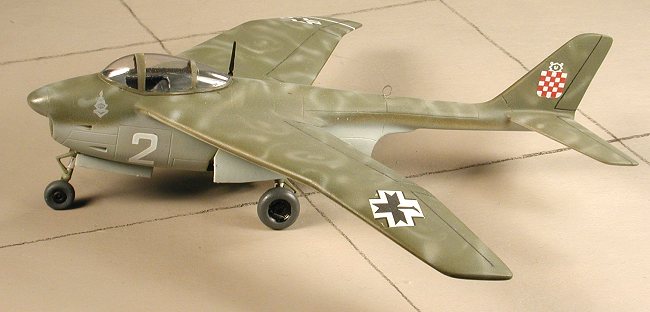
Review kit courtesy of me and my wallet!
Copyright ModelingMadness.com. All rights reserved. No reproduction in part or in whole without express permission from the editor.
If you would like your product reviewed fairly and fairly quickly, please contact the editor or see other details in the Note to Contributors.